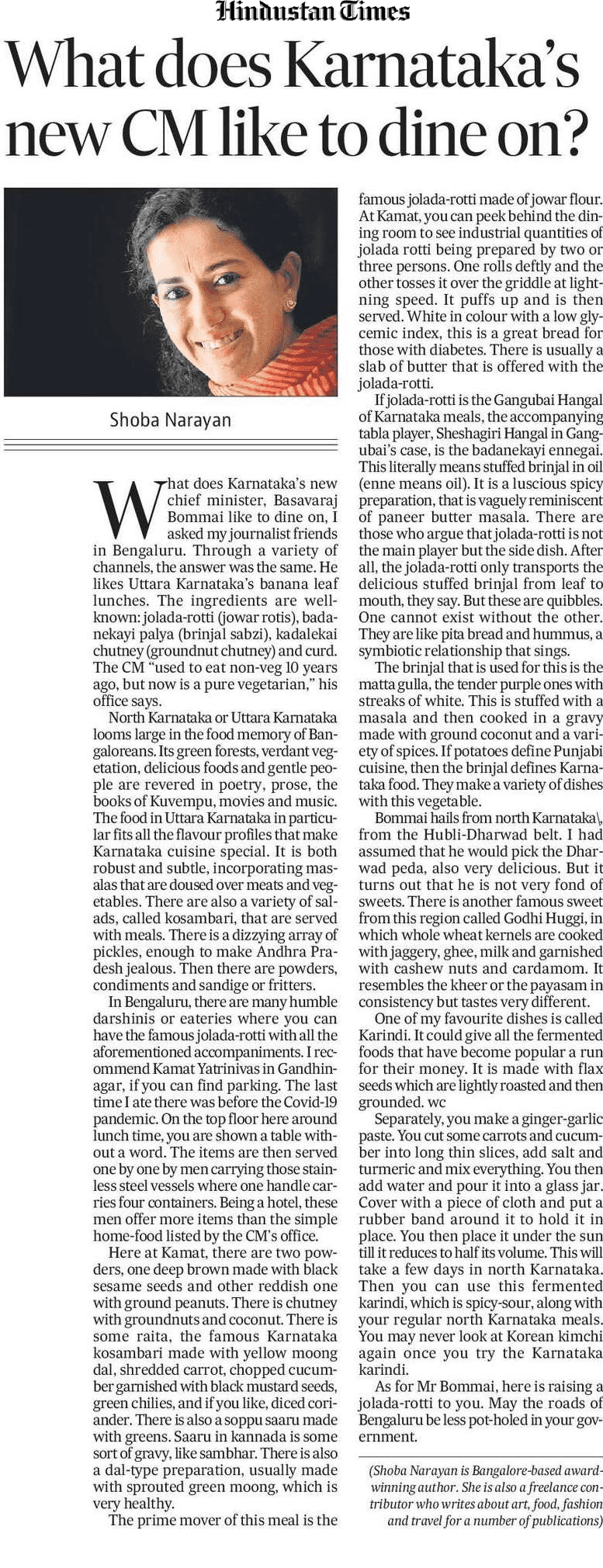Bangalore Talkies: What does Karnataka’s new CM like to dine on?
What does Karnataka’s new Chief Minister, Basavaraj Bommai like to dine on, I asked my journalist friends in Bangalore. Through a variety of channels, the answer was the same. He likes Uttara Karnataka’s banana leaf lunches. The ingredients are well known: jolada-rotti (jowar rotis), badnekayi palya (brinjal sabzi), kadalekai chutney (groundnut chutney) and curds. The CM “used to eat non-veg ten years ago, but now is a pure vegetarian,” says his office.
North Karnataka or Uttara Karnataka looms large in the food memory of Bangaloreans. Its green forests, verdant vegetation, delicious foods and gentle people are revered in poetry, prose– the books of Kuvempu, movies, and music. Uttara Karnataka food in particular, fit all the flavour profiles that make Karnataka food special. It is both robust and subtle, incorporating masalas that are doused over meats and vegetables. There are also a variety of salads, called kosambari that are served with meals. There are a dizzying array of pickles, enough to made Andhra Pradesh jealous. Then there are powders, condiments and sandige or fritters.
In Bangalore, there are many humble darshinis or eateries where you can have the famous jolada-rotti with all the aforementioned accompaniments. I recommend Kamat Yatrinivas in Gandhinagar– if you can find parking. The last time I ate there was before Covid-19. You go to the top floor around lunch time and are shown to a table without a word. Along come the items one by one, served by men carrying those four-in-one stainless steel vessels, where one handle carries four containers. Being a hotel, they offer more items than the simple home-food listed by the CM’s office.

Here at Kamat, there are two powders, one deep brown made with black sesame seeds and other reddish one with ground peanuts. There is the chutney with groundnuts and coconut. There is some raita, the famous Karnataka kosambari made with yellow moong dal, shredded carrot, chopped cucumber, garnished with black mustard seeds, green chilies, and if you like, diced coriander. There is also a soppu saaru made with greens. Saaru in kannada is some sort of gravy, like sambar. There is also a dal-type preparation, usually made with sprouted green moong– very healthy.
The prime mover of this meal is the famous jolada-rotti made of jowar flour. At Kamat, you can peek behind the dining room to see industrial quantities of jolada rotti being prepared by, basically two or three people. One rolls deftly and the other tosses it over the griddle at lightning speed. It puffs up and is sent off to be served. White in colour with a low glycemic index, this is a great bread for those with diabetes. There is usually a slab of butter that is offered with the jolada rotti.
If jolada rotti is the Gangubai Hangal of Karnataka meals, the accompanying tabla player– Sheshagiri Hangal in Gangubai’s case– is the badnekayi ennegai. This literally means stuffed brinjal in oil (enne means oil). It is a luscious spicy preparation, that is vaguely reminiscent of paneer butter masala. There are those who argue that the jolada rotti is not the main player but the side-dish. After all, the jolada rotti only transports the delicious stuffed brinjal from leaf to mouth, they say. But these are quibbles. One cannot exist without the other. They are like pita bread and hummus– a symbiotic relationship that sings.
The brinjal that is used for this is the matta gulla, the tender purple ones with streaks of white. This is stuffed with a masala and then cooked in a gravy made with ground coconut and a variety of spices. If aloo or potatoes define Punjabi cuisine, then the brinjal defines Karnataka cuisine. They make a variety of dishes with this vegetable.
Bommai hails from North Karnataka, from the Hubli-Dharwar belt. I had assumed that he would pick the Dharwar peda, also very delicious. But it turns out that this CM is not very fond of sweets. There is another famous sweet from this region called Godhi Huggi, in which whole wheat kernels are cooked with jaggery, ghee, milk and garnished with cashewnuts and cardamom. It resembles the kheer or the payasam in consistency but tastes very different.
One of my favourite dishes is called Karindi. It could give all the fermented foods that have become popular a run for their money. It is made with flax seeds that are lightly roasted and then ground. Separately, you make a ginger-garlic paste. You cut some carrots and cucumber into long thin slices. Add salt and turmeric. Mix everything. Add water till it becomes slightly water. Pour into a glass jar. Cover with a piece of cloth with a rubber band to hold in place. Place outside under the sun till it reduces to half its volume. This will take a few days in North Karnataka. Then you can use this fermented karindi, which is spicy-sour along with your regular North Karnataka meals. You may never look at Korean kimchi again once you try the Karnataka karindi.
As for Mr. Bommai, here is raising a jolada-rotti to you. May the roads of Bangalore be less pot-holed in your government.
Shoba Narayan is Bengaluru-based award-winning author. She is also a freelance contributor who writes about art, food, fashion and travel for a number of publications.




Leave A Comment